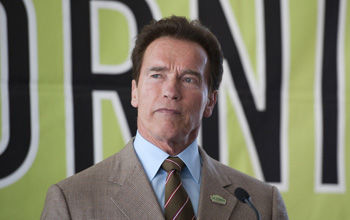Gov. Arnold Schwarzenegger will revive a plan to house 15,000 nonviolent felons in county jails instead of state prisons, a cost-cutting move that likely would result in some inmates leaving jail early.

Gov. Arnold Schwarzenegger (HECTOR AMEZCUA / Bee file, 2010)
The Republican governor will include the proposal in his May budget revision today. His office warned earlier this week that the package will contain "absolutely terrible cuts" to shrink a nearly $20 billion deficit.
Local law enforcement agencies vigorously opposed a similar idea that Schwarzenegger floated in January, in part because the state would not have reimbursed counties for housing inmates. That proposal would have saved the state $291.6 million.
The governor's latest plan would pay counties just under $12,000 per inmate, said Nick Warner, legislative director for the California State Sheriffs' Association. That represents less than half the savings the state would realize by avoiding the expensive costs of prison incarceration.
"It still puts a burden on local governments, but it's better than getting inmates without the money," Sacramento County Sheriff John McGinness said.
Schwarzenegger press secretary Aaron McLear declined to comment on the proposal.
Under the plan, only nonserious, nonviolent, non-sex offender felons would be eligible to serve time in local jails for up to three years, Warner said.
It is unclear to what extent state prisoners would displace county inmates. Warner said 32 counties have court-ordered population caps, including most in the Sacramento region. If the plan calls for state prisoners to serve in those jails, sheriffs would release lower-level county inmates.
"If we're replacing one body with one body, how safe is that going to be for the public?" said Assemblyman Curt Hagman, R-Chino Hills, vice chairman of the Assembly Public Safety Committee. "Are there going to be protections for counties that are impacted?"
Warner said sheriffs are already releasing jail inmates early because of overcrowding. In many cases, they require those inmates to undergo electronic monitoring or drug rehabilitation once out of jail.
"This is markedly better than the January proposal," Warner said, noting that the plan includes additional new funding for public safety programs. "To the governor's credit, he listened to us."
Hagman said he wasn't supporting the idea but is willing to discuss ways in which it might work, such as transferring inmates to counties that have jail space.
"I'm realistic, and if we have to cut $20 billion, everything has to take a cut," he said.
Hagman also noted that the proposal could be helpful in avoiding judicial orders to release state prisoners.
California houses an inmate population of roughly 150,000 in a system designed for 80,000. A federal court last year ordered the state to reduce its population to 110,000 within two years.
Schwarzenegger officials have submitted an inmate reduction plan to the court that relies on sending fewer people to prison for parole violations and lower-level crimes. But they have filed an appeal to the U.S. Supreme Court that challenges the lower court's ability to order states to release prisoners.
In his revised budget proposal today, Schwarzenegger is expected to rely heavily on a series of contingency cuts he outlined in his January budget. Those may include the elimination of the state's welfare-to-work program and in-home health care for disabled and elderly residents.











